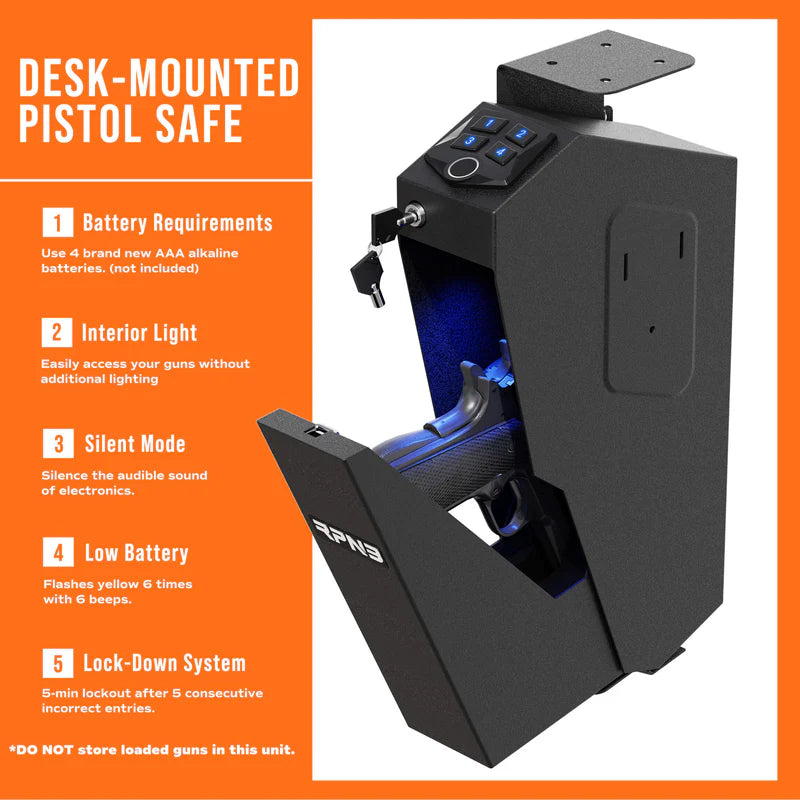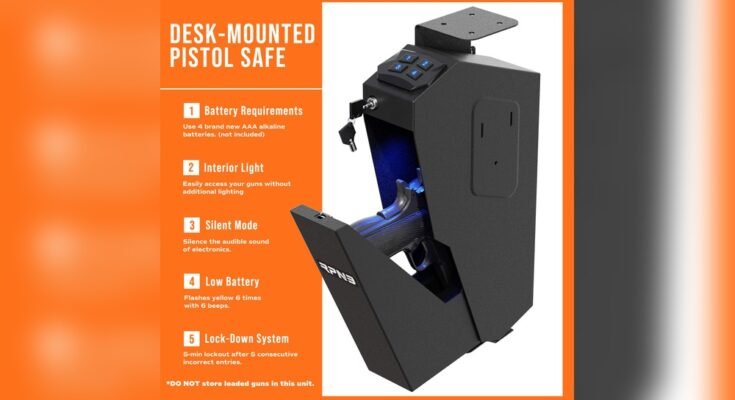Are you wondering if pistol safes need batteries to keep your firearm secure? This question is more important than you might think.
Whether you’re new to gun ownership or looking to upgrade your storage, understanding how pistol safes work can save you time, money, and frustration. Imagine needing quick access to your pistol, only to find the safe won’t open because of a dead battery.
That’s why you need to know exactly what to expect. Keep reading to discover the truth about pistol safe power sources and how to choose the right one for your needs.

Types Of Pistol Safes
Pistol safes come in different types. Each type offers unique security and convenience. Choosing the right safe depends on your needs and preferences. Understanding the types helps you decide if batteries are needed.
Mechanical Safes
Mechanical safes work without batteries. They use manual locks or combination dials. These safes are reliable and simple. No power means no risk of battery failure. They need physical effort to open.
Electronic Safes
Electronic safes require batteries to operate. They use digital keypads for quick access. Batteries power the locking and unlocking system. Some models alert you when batteries run low. Easy to use, but battery life is a factor.
Biometric Safes
Biometric safes use fingerprint recognition. Batteries power the scanner and lock system. They offer fast, keyless access. Battery checks are important to avoid lockouts. Advanced security with a tech touch.
Battery Usage In Electronic Safes
Electronic pistol safes often need batteries to work. These batteries power the lock and keypad. Without power, the safe cannot open or close electronically.
Understanding battery use helps keep your safe ready at all times. It also prevents lockouts caused by dead batteries. Most safes use common batteries, making replacements easy.
Power Requirements
Electronic safes usually use AA or AAA batteries. Some models use 9-volt batteries. The battery type depends on the safe’s design and brand.
Battery power runs the keypad and locking system. Some safes have a backup battery option. This keeps the safe working if the main battery dies.
Battery Life Expectancy
Batteries in electronic safes last between six months and two years. Usage frequency affects battery life. More use drains the battery faster.
Low battery warnings often show on the keypad. These alerts give time to replace batteries before failure. Ignoring warnings risks locking yourself out.
Battery Replacement Process
Replacing batteries is simple and quick. Most safes have a battery compartment inside the door. Open the safe and locate the battery holder.
Remove old batteries and insert new ones with correct polarity. Always use fresh, high-quality batteries for best results. Close the compartment and test the safe immediately.
Mechanical Safes And Battery Independence
Mechanical safes offer a reliable way to secure pistols without using batteries. These safes rely on manual locks that work without power. This feature makes them useful in any situation, even during power failures or battery issues.
Choosing a mechanical safe means no need to worry about battery life. The safe stays functional all the time. This makes mechanical safes a trusted choice for many gun owners who want simple and steady protection.
How Mechanical Locks Work
Mechanical locks use physical parts like dials, levers, and tumblers. Turning the dial or moving the lever aligns the internal parts. When aligned correctly, the lock opens. No electricity or batteries are needed for this process. The lock depends on precise movements and craftsmanship.
Users enter a combination by rotating the dial to specific numbers. Each number moves the lock parts to the right position. The safe then unlocks with a click. This method has been used for decades and remains effective and secure.
Advantages Of No Battery Dependency
No battery means the safe works all the time. No worries about dead or missing batteries. This is vital in emergencies when quick access matters. Mechanical safes are low maintenance and cost less over time. They do not need battery replacements or charging.
Mechanical safes are also less likely to fail due to electronic issues. They resist power surges and technical faults. This makes them more durable and long-lasting. For gun owners wanting simple and strong security, mechanical safes are an excellent choice.

Biometric Safes And Battery Needs
Biometric safes use advanced technology to secure pistols. They rely on fingerprint scans to allow quick access. This makes them very convenient and safe. But these safes need power to work. Batteries play a key role in biometric safes. Understanding their battery needs helps users avoid lockouts and maintain security.
Fingerprint Recognition Technology
Fingerprint recognition is the main feature of biometric safes. It scans your fingerprint to verify your identity. This process needs electronic parts that run on battery power. Without batteries, the scanner cannot function. The safe will not open with fingerprint access if the battery dies. This technology requires a steady power supply to work well. Low battery can cause slow or failed fingerprint scans.
Battery Backup Options
Many biometric safes include battery backup options. Some safes use standard AA or AAA batteries. Others have rechargeable lithium-ion batteries. Backup power helps keep the safe operational during battery failure. Some models also offer external power ports. This allows temporary power connection to unlock the safe. Battery indicators warn users when power runs low. Changing batteries regularly ensures the safe stays functional. Battery backup helps avoid lockouts and keeps your pistol secure.
Risks Of Battery Failure
Battery failure in pistol safes poses real risks. The safe might not open when needed. This could cause stress or danger in urgent moments. Knowing these risks helps you prepare better.
Lockout Scenarios
Lockout happens when the battery dies completely. The keypad stops working. You cannot enter your code or open the safe. This can delay access to your firearm. Such delays can be serious in emergencies. Some safes give low battery warnings. Ignoring them increases lockout chances. Regular battery checks reduce this risk.
Emergency Override Features
Many safes include emergency override options. These help if the battery fails. Common methods are physical keys or backup power ports. Physical keys allow manual opening. Backup ports let you connect external power. These features add safety and peace of mind. Always know how to use your safe’s override. Testing override options is important too.

Choosing The Right Pistol Safe
Selecting a pistol safe is important for keeping your firearm secure and accessible. You want a safe that fits your needs and lifestyle. Consider how you will use the safe every day. Think about the balance between protection and ease of use. Some safes need batteries, while others do not. Understanding these details helps you make a smart choice.
Considering Battery Dependability
Many modern pistol safes use batteries to power electronic locks. Batteries need regular replacement or charging. A dead battery can lock you out of your safe. Choose a safe with a low battery warning. Some safes offer backup keys for emergencies. Look for models with reliable battery life. Consider how easy it is to change the batteries. Think about your ability to maintain the safe’s power source.
Balancing Security And Convenience
Security is the main reason for a pistol safe. But convenience matters too. You want quick access in urgent situations. Electronic locks are fast but need power. Mechanical locks do not need batteries but might be slower. Find a safe that offers both strong protection and easy access. Make sure the locking system fits your comfort level. The right balance keeps your pistol safe and ready.
Maintaining Your Pistol Safe
Maintaining your pistol safe is essential for security and longevity. A well-kept safe works smoothly and protects your firearms effectively. Proper care prevents malfunctions and extends the safe’s life.
Regular Battery Checks
Many pistol safes use batteries for electronic locks. Check the batteries often to avoid lockouts. Replace batteries at least once a year or sooner if needed. Keep spare batteries nearby for emergencies. Low batteries can cause the keypad to fail.
Safe Care Tips
Keep the safe clean and dry. Wipe the exterior with a soft cloth to remove dust. Avoid harsh chemicals that can damage the finish. Lubricate the locking mechanism occasionally with a recommended oil. Store the safe in a cool, dry place to prevent rust.
Frequently Asked Questions
Do All Pistol Safes Need Batteries To Operate?
Not all pistol safes require batteries. Mechanical safes operate without power, while electronic safes typically need batteries for keypad or biometric functions. Always check the safe’s specifications to know if batteries are necessary for its locking mechanism.
How Long Do Pistol Safe Batteries Usually Last?
Pistol safe batteries generally last between 6 to 12 months under normal use. Battery life depends on the safe’s model, frequency of access, and type of batteries used. Regularly replacing batteries ensures reliable operation and prevents lockouts.
What Happens If Pistol Safe Batteries Die?
If pistol safe batteries die, electronic locks may fail to open. Many safes include a backup key or external battery port for emergency access. It’s essential to keep backup options ready to avoid being locked out during battery failure.
Can I Use Rechargeable Batteries In Pistol Safes?
Yes, rechargeable batteries can be used in pistol safes if they match the required size and voltage. However, rechargeable batteries may have shorter life spans between charges. Check the manufacturer’s recommendations before using rechargeable batteries.
Conclusion
Pistol safes often need batteries to work properly. Battery power keeps electronic locks secure and quick. Without batteries, some safes won’t open at all. Mechanical safes do not require batteries, though. Choosing the right safe depends on your needs. Always check the battery type and replacement ease.
Keep spare batteries nearby to avoid lockouts. Safe security depends on proper maintenance and care. Batteries add convenience but need regular attention. Understanding these points helps you pick the best safe for you.



